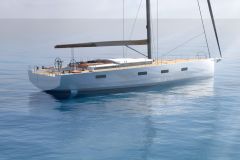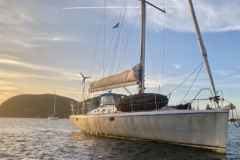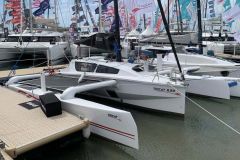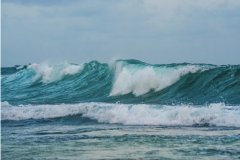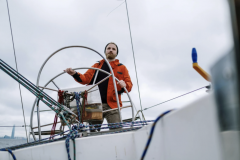A little history
The 5o5 born from the hand of John Westell, at the request of Alain Cettier, president of the Association des Canetons (dinghies with 5.05 m restrictions) was born in 1954. It all began in 1953 when tests were organised by the IYRU (International Yacht Racing Union, now ISAF) to choose the dinghy to be used during the Olympic Games. It was the Flying Dutchman that won the membership of the International Sailing Federation against the Coronet, a small 5.48 metre dinghy designed by the English John Westell.
However, the Coronet was noticed by Alain Cettier, president of the largest fleet of small racing boats, who asked the Anglo-Saxon designer to reduce the size of the boat to 5.05 metres and the sail plan to 16 m2 to create a new model. It is during the General Assembly of the Association des Canetons that the drawing of 5o5 is adopted.
In 1955, the dinghy obtained international class status and the first World Championship was held in La Baule in 1956. The rules of measurement impose that the sail plan and the shape of the hull be controlled leaving the rest of the boat free to correspond to the desires of their owner. In terms of materials, only the mast should be made of aluminium and wood. Finally, its weight must not exceed 127.4 kg without the sails.


A very powerful small dinghy
The 5o5 is the first boat of this type to have so many innovations and will inspire the following series: the trapeze which replaces the return board, the hull deflectors, the spinnaker which makes its first appearance on a dinghy, the caissons designed to serve as reserve buoyancy and the self-draining flaps allowing the boat to be emptied in a few seconds after straightening the boat.
Today, the 5o5 is still based on the same design, even if it has undergone some changes. Originally, the sails were made of cotton and are now made of mylar/kevlar film. A spinnaker swallower has been added in front of the forestay and the hull which was built of moulded wood is now made of polyester sandwich, epoxy or composite materials. It has thus been able to gain in resistance and competitiveness.

In 2001, after two years of testing, the class adopted the large spinnaker, which improved the boat's speed downwind.
This dinghy is a very fast boat, thanks to its light hull which allows it to glide easily as well as its sail of 16 m2 upwind and almost 45 in the wide edges. Its crew must be perfectly trained to master this small boat very marine and sensitive to adjustments.

A legendary boat
The 5o5 is quickly adopted in the regatta world and develops easily. In 1955, it was already produced at 100 units.
Today, the class is present in 18 countries including the United States, Canada, Australia, New Zealand, Southern Africa, but also many European countries. 9,000 units are registered worldwide and 50 new models are launched each year.
It was on board a 5o5 that many sailing champions were crowned like Paul Elvström or the Pajot brothers, but also Marcel Buffet, Nicolas Loday and that many sailors made tests like Paul Cayard, Denis Conner, Peter Blake.

Share your Nav experience and memories with us and leave a message or photo in the comments below.
Specifications
| Length | 5,05 m |
| Width | 1.88 m at the liston and 1.24 m at the waterline |
| Mainsail | 12,30 m2 |
| Foc | 4,94 m |
| Spinnaker | 27 to 29 m2 |
| Minimum weight | 127.4 kg without sails |

